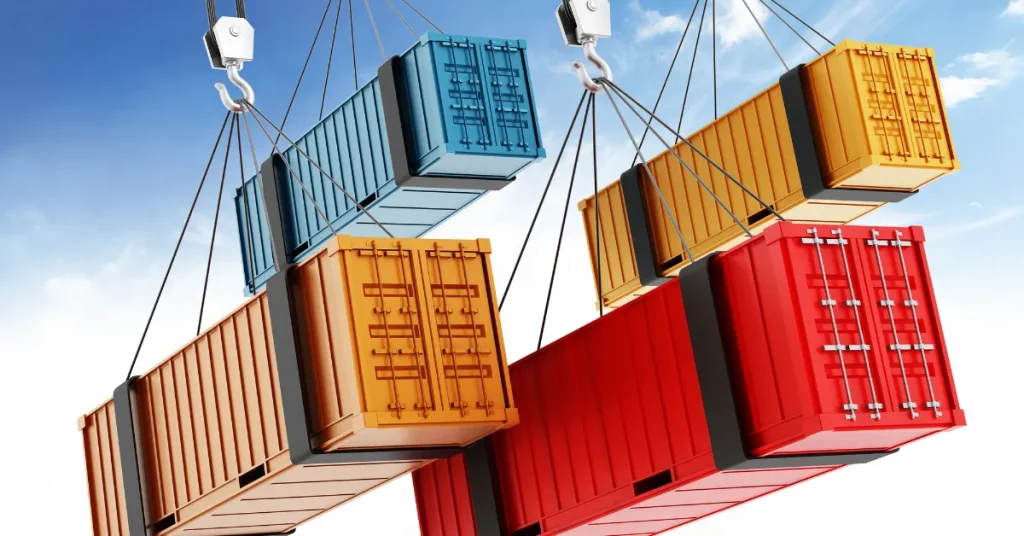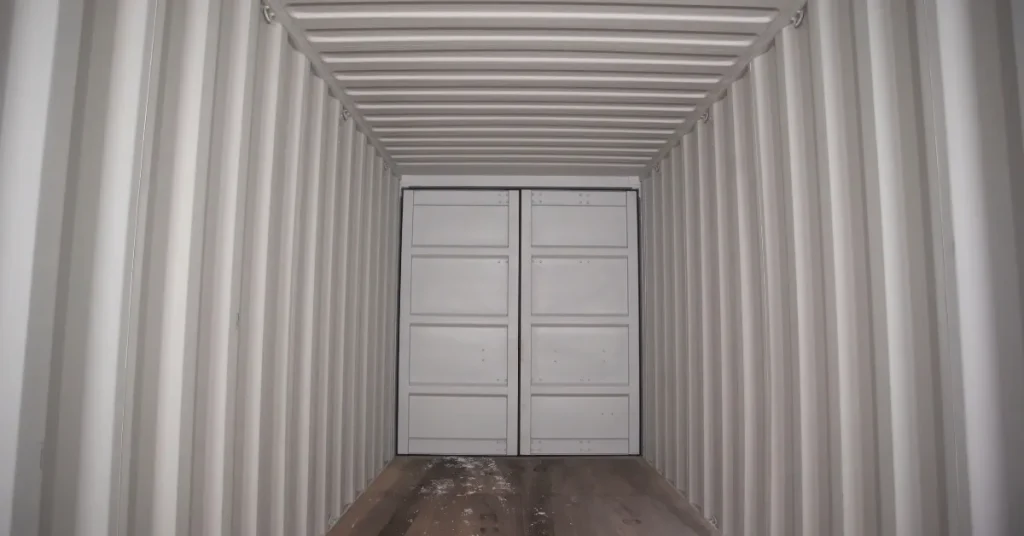Shipping container walls are typically 14 gauge steel, around 1.9mm to 2mm thick. The corrugated walls contribute to the containers’ overall strength and rigidity.
Understanding the construction of a shipping container is essential for assessing its capacity for modification and storage. Made primarily from Corten steel, known for its weather-resistant properties, these containers withstand harsh environments.
The walls’ corrugated design not only adds to their durability but also helps maintain structural integrity while stacked during transportation.
Shipping containers serve as a reliable solution for various applications, including storage, transportation, and innovative architectural projects.
By acknowledging their build quality and dimensions, individuals and businesses alike can effectively utilize these versatile steel boxes for their intended purposes.
The thickness of the walls plays a crucial role in the container’s ability to secure and protect the contents inside, making this information vital for potential modifications or customizations.

The Anatomy Of Shipping Containers
The Anatomy of Shipping Containers: Understanding the intricacies of shipping containers is crucial for both shipping professionals and aspiring DIY enthusiasts. These giants of trade have a robust design, tailored for durability and safety.
The thickness of the walls plays a vital role in their structural integrity. Let’s delve deeper into the make-up and dimensions of container walls.
Material Composition
Shipping container walls boast exceptional strength, thanks to their construction material. Made mainly from corten steel, known for its corrosion-resistant properties, these walls can endure harsh weather conditions.
The typical wall thickness is around 14-gauge, translating to roughly 1.9mm or 0.075 inches.
- Corrosion Resistance: Corten steel forms a stable rust-like appearance after exposure to weather, preventing further corrosion.
- Durability: The high-quality steel ensures the container can handle heavy loads and multiple trips across the oceans.
Standard Sizes And Dimensions
Standard shipping containers come in various sizes to accommodate different cargo types. The most common dimensions are 20-foot and 40-foot lengths. However, each container adheres to standard sizing rules to ensure they fit perfectly on ships, trucks, and trains.
| Type | Length | Width | Height |
| Standard 20′ | 20 feet (6.06 m) | 8 feet (2.44 m) | 8.6 feet (2.59 m) |
| Standard 40′ | 40 feet (12.2 m) | 8 feet (2.44 m) | 8.6 feet (2.59 m) |
Exact dimensions may vary slightly depending on the manufacturing company. Yet, these slight variations rarely compromise the standard utility of the containers during shipping.
Shipping Container Wall Thickness
Understanding the thickness of shipping container walls is vital for many reasons. The walls are key to the container’s ability to stack, stability, and overall durability.
Whether for storage, transport, or even conversion into a living space, knowing the wall thickness informs structural integrity and insulation properties.
Measurement Units
Wall thickness measurements are often shared in millimeters or inches. These units are the standard for international shipping and help in comparing containers worldwide.
| Measurement Unit | Equivalent |
| Millimeters (mm) | 0.039 inches |
| Inches (in) | 25.4 millimeters |
Variability Across Different Types
Containers vary in wall thickness.
Standard containers typically have walls around 2mm thick.
Specialized containers may feature thicker walls depending on their use.
- Reefer containers have thicker walls for insulation.
- Containers used for heavy cargo might have reinforced walls for extra support.
Different brands and models might affect wall thickness. Always check with the manufacturer for precise measurements.
Factors Influencing Wall Thickness

The walls of a shipping container play a critical role in maintaining its strength and durability.
Various factors determine how thick these steel panels should be. Below, we dive into three key elements that influence wall thickness in shipping containers.
Container Purpose
Different uses call for different container specifications. Shipping containers meant for industrial purposes typically feature thicker walls. This is due to the heavy-duty nature of industrial applications.
In contrast, containers repurposed for storage or housing might have slightly thinner walls, catering to ease of modification and insulation needs.
Climate Considerations
Areas with extreme weather conditions necessitate shipping containers with enhanced wall thickness.
Thicker walls provide improved insulation from heat, cold, and humidity, safeguarding the contents within. This ensures the longevity of both the container and its contents.
Load Requirements
The anticipated load also determines wall thickness.
Containers expected to carry heavy loads need sturdy walls to prevent damage.
Here’s a brief overview:
| Load Type | Typical Wall Thickness |
| Light Loads | Less Thick |
| Heavy Loads | More Thick |
A balance between material strength and efficiency is key to wall thickness for optimal performance.
Impact Of Wall Thickness
The thickness of shipping container walls plays a key role in their performance. Whether used for transporting goods or as a building material, wall thickness impacts several attributes.
Let’s explore how this feature influences structural integrity, insulation, and weight.
Structural Integrity
Shipping containers must be strong. The walls, made from corrugated steel, endure heavy loads and harsh weather. Thicker walls mean more strength. This allows them to stack high on ships and on land.
But, there’s a balance. Make them too thick, and they’re hard to move. Just right, they last for years.
Insulation Properties
Wall thickness affects temperature control. Thinner walls have less insulation. This means they can’t keep the inside cool or warm as well. Thicker walls, on the other hand, better resist temperature changes.
Adding insulation is an option, too. With the right thickness and insulation, containers turn into comfortable spaces.
Weight Implications
Weight is important for transport and handling. Thicker walls increase the container’s weight. This impacts how they’re lifted and moved. It also affects shipping costs.
Lighter containers can save money. They use less fuel to transport. This makes them eco-friendlier as well.
Customizing Container Walls

When it comes to the thick steel walls of shipping containers, customization is key for personal or business projects. Knowing the standard thickness is just the start. Now let’s explore how to tailor these sturdy walls for specific needs.
Modifications For Specific Uses
Shipping containers adapt to various functions. Here’s how:
- Insulation: Add for temperature control.
- Windows: Include for natural light and air.
- Doors: Install for easy access.
- Interior Walls: Create rooms or compartments.
Each modification transforms the container to fit unique needs. Whether for a cozy living space or a mobile office, customizing the walls ensures maximum utility.
Cutting And Reinforcing Techniques
Cutting involves precision. Here are the steps:
- Measure and mark the cut area.
- Use plasma cutters or grinders for accuracy.
- Remove the cut piece carefully.
Post cutting, reinforcing is essential. Steel posts or beams ensure structural integrity. Secure the new framework firmly to uphold the container’s strength.
| Modification | Tool Used | Reinforcement Needed |
| Door | Plasma Cutter | Steel Beams |
| Window | Angle Grinder | Steel Posts |
Legislation And Standards
Understanding the Legislation and Standards that apply to shipping container walls is crucial. These regulations ensure containers are safe for transport and sturdy enough for various construction projects. Here, we delve into the specifics that govern the thickness of these walls.
International Building Codes
Shipping containers repurposed for building fall under distinct International Building Codes (IBC). These codes outline the minimum requirements to guarantee structural safety. They cover aspects such as:
- Material quality
- Design standards
- Building limits
IBC compliance is essential. It ensures that modified containers are legally recognized as safe living or working spaces.
Safety Regulations For Thickness
Safety regulations specify the minimum wall thickness for shipping containers. This is to withstand the stresses of stacking, handling, and harsh weather. These regulations include:
| Container Type | Minimum Thickness |
| Dry Storage Container | 2mm |
| Refrigerated Container | 3mm |
| Specialized Container | Varies based on design |
Meeting these thickness standards ensures durability and longevity, vital for both shipping and building.
FAQs About How Thick Are Shipping Container Walls
How Thick Is A Shipping Container Wall Mm?
A standard shipping container wall typically measures approximately 2 mm in thickness.
Are The Walls Of A Shipping Container Structural?
Yes, the walls of a shipping container are structural. They provide strength, support the roof and contribute to load-bearing when stacked.
How Thick Is The Steel On A Container?
The steel on standard shipping containers typically measures between 1. 6 mm to 2. 0 mm thick.
Will A Shipping Container Stop A Bullet?
Most shipping containers are made of steel, which can stop many types of small arms bullets, depending on the caliber and distance fired.
Conclusion
Understanding the thickness of shipping container walls is vital for gauging their durability and suitability for various modifications. We’ve explored the standard dimensions and materials that contribute to their robustness.
Whether for storage, transportation, or innovative construction, properly assessing container wall thickness ensures your project is built on a solid foundation.
Keep this knowledge in hand as you embark on your shipping container endeavors.
Resources:
1. https://www.dla.mil/Troop-Support/Construction-and-Equipment/Containers/
